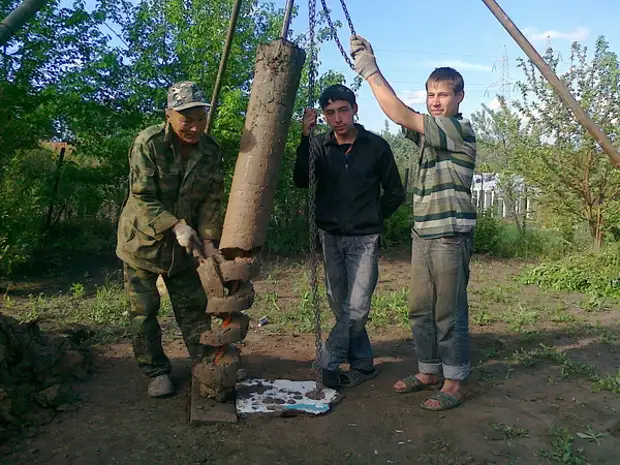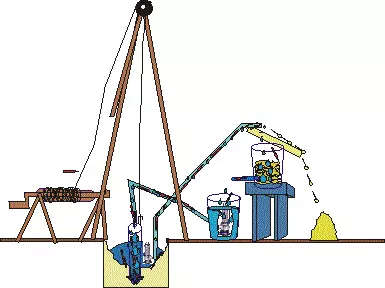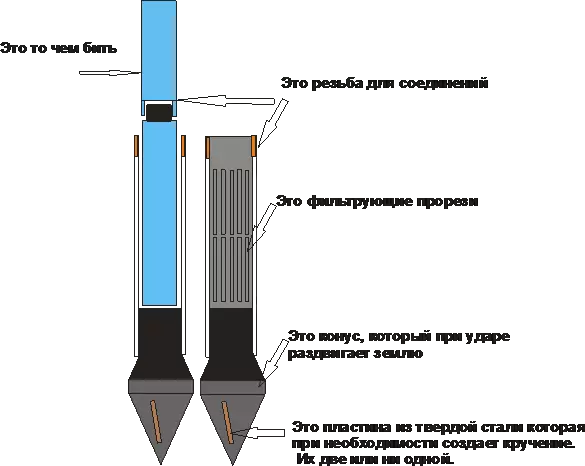After reading a bunch of useful information on the drilling of wells and the choke of the wells, I decided to share with you my method of water extraction, easier and affordable. First - I will tell you how to make a well, well, very simple way.

In practice, I personally did not try this method, but led the article of my friend who deals with this for money.
I think it will be interesting to you, and I personally try this method in the summer. It may be useful in the future. The principle is fond of simple. I made an animated picture showing how it should happen. Now look: First you need to buy 2 pumps, two barrels, hoses and pipes. Several 6 meter bars and of course couplings for the pipe. The shovel of the pit is about the 1-meter x 1 meter and a depth of 60 cm. The pipes should be about 2 meters long (can and longer). With both ends of the pipes you need to cut the thread. In the future, when the pipe will enter the ground, the second tube is screwed to it with the help of the sleeve, and so on until you deepen to the desired depth.

The first pipe has a teeth from one side, which can be made with a grinder, and the second side of the pipe has threads. Initially, you screw the adapter with the end part of your hose. I was recommended a cut to make pipes with a length of 4-6 meters long. So less than gimoro with twisted adapter, and the weight of the design becomes more, which allows the pipe to more quickly crash into the ground. So apart. Vnamel from the bar we make Trenogu and put on a dull pit. On top to tripod, we attach a roller through which we skip the rope. Trenog is better to fasten, connecting the bottom and in the middle three legs with the same bar. A little further from the triogi peeling into the ground wooden or metal pin. It is better to even make a drum as to raise water from the well. It is kpripim one end of the rope. The other is tied to the pipe.
Pipe with connected fitting insert into the pit. Next, go to the barrels. Near the pit, one barrel is put on the ground, the second on the platform made from the undergraduate materials to the height of the top level of the first barrel. Blind of the top barrel drill a hole and insert a pipe with a tap. We feed the upper barrel of dry grass, which serves as a kind of filter, in the top obliquely put the mesh. The network will clean the large fractions of the soil that fell with water, then this soil will simply be replaced down. The grass filters small pieces of soil and from the top barrel flows into the bottom.
In the bottom barrel there is a pump that takes water, under pressure it gives it to your pipe. The pipe is released from the bottom of the pipe and the soil is flushed. This muddy suspension falls into your pit. The second soil pump pumped up muddy water into the upper barrel. At the same time, a small part of the soil falls into the barrel. The tracking part is starting from the pit in front of his eyes. After some time, you remove it with a shovel.
So the pipe itself is plunged, the ground as a geyser throws up. You only need to reclaim the soil and look at the level of the washed soil.
The manual method is tested personally.

I do not use for this casing, a bora, grandmother, and other things ... The pipe for such a well is needed in my opinion 5-10 cm., And no more: it fully provides uninterrupted water supply using a domestic high-performance pump. The method is simple as twice two. At the same time, you do not pay the drillers, and this is at the beginning of 2007 it costs about 30-45 thousand rubles. Digging the well is also not enough. Without the cost of the rings, you pay about a thousand American tuggers. And if you are not a rich man and saved bucks - for you a significant amount of the family budget, then this topic is exactly yours.
To begin with, you need to stock pipes. I recommend pipes with a diameter of about 5 cm. The length of the pipes must be approximately 1.5 - 2 meters. Take just in case of pieces 8. At the ends of the pipes, cut the thread and buy the sleeve so that you can connect the pipes to the bushings. Buy also steel rod. Its length should be 2-2.5 meters. Prut also has a thread at the ends and connecting bushings of their diameter. It will also be necessary to make a steel cone, the diameter of which is larger than the pipe diameter. It is welded a piece of pipe with cutting longitudinal slots. These slots should be limited to the grid. They are a filter. It is possible to reveal strips from solid steel to the cone (for example, the pieces of a sharpened flat file), but only that when they hit, these bands created a small rotation toward the pipe spinning. Next, we do the following:
A pipe is clogged (and thus the well is formed) with the help of your composite bar, consisting of two segments of the steel rod dia. 20-30 mm. and 2.5 m long, threaded at the ends. This bar descends inside the pipe (filter) and rests on the cone welded to the filter. Together with a partner, installing a filter vertically on a plunder, we take hands for a bar, raise it up and sharply lower - shorter, beam. The punch of the rod at the same time falls on the cone. When, the filter will open, the soaked paint panel is wound onto its threaded part, then the clutch is rotated, and the next piece of pipe is 2 ... 2.5 m. If the rod is short, increase it and beyond. After scoring for a depth of 3-6 meters, check if there is water in the well. We take a bucket of water and pour into the pipe (we do not pull out the rod at the same time). If water is in the pipe; It does not go, it means that we did not reach the aquifer. Beying another meter, check again, pouring water. The aquifers are filmed, therefore, in my opinion, rational break through the well on the second aquifer or at least at the bottom of the first layer. And the layer is thick and up to 10 meters.
It does not always be justified to check the aquifer, pouring water into the pipe. In some cases, water goes into the sand layer. After all, I can't check, to which layer I reached. If water slowly leaves, it means that we are theoretically at the beginning of the aquifer; We tear another 0.5-1 m, pour water. Now the water should quickly go into the pipe - reached the aquifer. We start pulling out the bar, and she does not go, jammed. Do not be mistaken, take the hammer and bey on the rod, but not on top, and on the side with the top. With these blows, you create vibration, and the soil that got through the filter grid into the pipe, "dies", the rod is released. Having pulled out a barbell, turn the fitting with the pump on the well. Can be manual or electric. After pumping two or three buckets of muddy water usually goes clean.
It is advisable to roll out a couple of two hundred liter barrels. You are making sure the amount of water and in its quality. Then pour clean water into the pan and boil, and then try to taste - what quality it is. If it is bad, then after boiling it becomes reddish or muddy, and the sediment falls on the bottom. Then you have to deepen the well another meter. Do not confuse with a sediment from lime water, if it goes through the limestone breed.
It happens that: in a few years, water in the well disappears (not "takes" the electric pump, and the hand shakes very tight). This is a sign of clogging filter. Many are washed well with various solutions. I argue that it gives a small effect in practice, this washing only poisoned the aquifer. It's easier and more reliable to pull the filter from the ground, but it does not always succeed. This happens quite rarely with a competent approach to the case, and in this case you have to use the car crane, a jack. In this case, you need to lower the bar in the well and hit the cone a dozen times, after that apply the listed mechanisms. After 10-20 cm, the rise will stop again; You need to hit again, and after 2 hours you pull out the filter. As a rule, it turns out to be coated with a black oily flare. Type water, water from above the filter and a metal brushed trite on the grid. For better cleaning, paint "Silit", which from rust will be aswaling. Gradually, the raid is washed off.
Check and pipes: sometimes rust breaks into small fistulas. Because of this, the integrity and well may not work (due to the supply of air or ingressing the soil). Better, of course, replace the pipes new. And again you can score them in the same place, where it used to be a well.
This method is checked in practice. For this method, hundreds of wells were pretended. All work to this day. Some were clogged to a depth of more than 20 meters, in the artesian layers of water.
